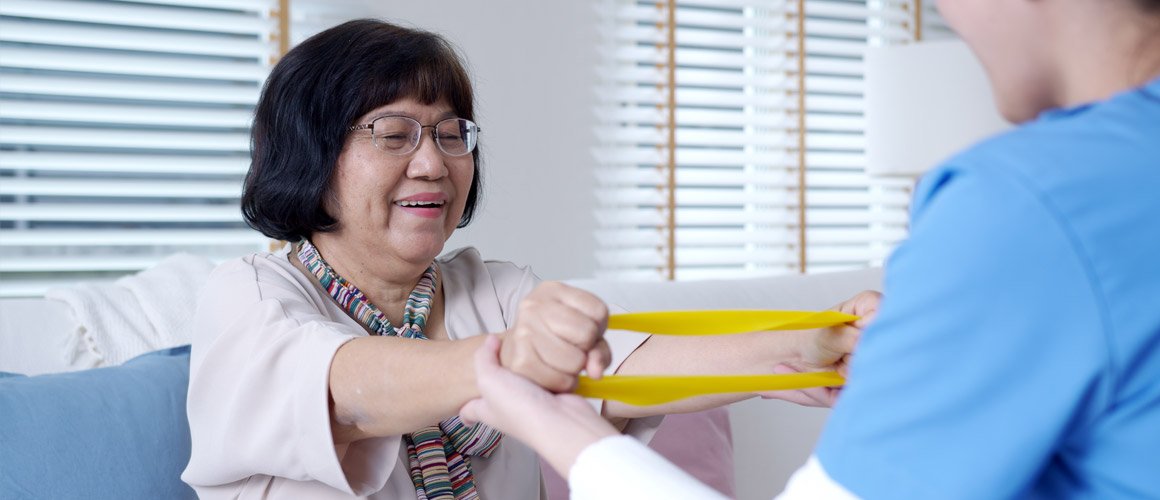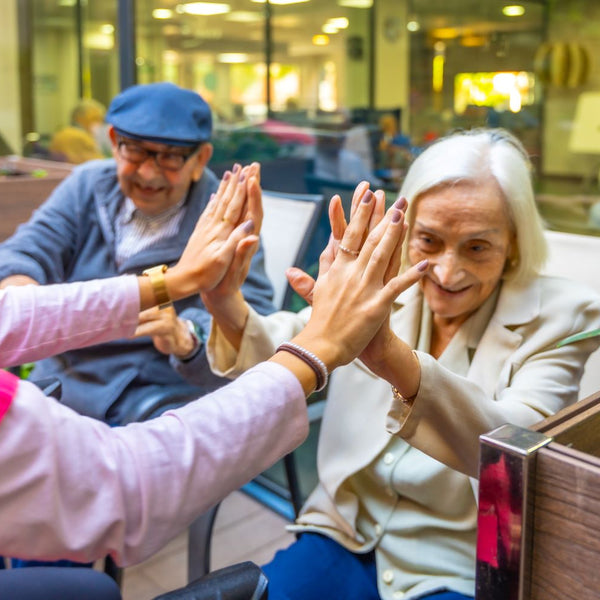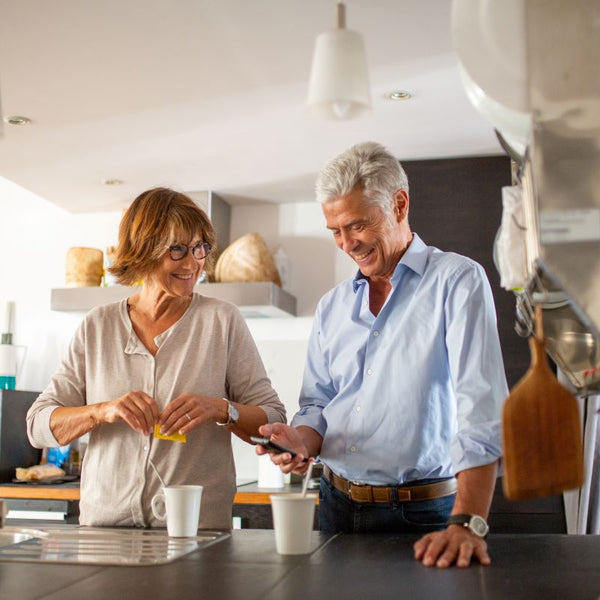Staying active and moving around can become more of a challenge as people get older. Sometimes it can be because of a health condition, general aches and pains or lifestyle changes that cause a reduction in regular activity or exercise.
The season and weather can also play a role in a more sedentary lifestyle, with cold temperatures, icy or slippery conditions, short daylight hours and rain all being things that can stop some older people from taking a walk or spending time being active outside. However, a lack of physical activity can result in a range of increased health risks and can have a significant impact on quality of life.
In this article, we’ve compiled some gentle exercises that can all be done in the home. If carried out regularly, gentle exercise is beneficial in many ways to older adults, both physically and mentally. It can help someone in their later years to maintain or improve their mobility, enjoy a better quality of life, health and wellbeing, and can also help improve balance and reduce the risk of a fall.
Jump to:
- Why is it important for the elderly to stay active?
- What kind of exercises are suitable for the elderly?
- Seated exercises for seniors to do at home
- Standing exercises for seniors to do at home
- Walking exercises for seniors to do at home
- Other ways to support an active lifestyle for older adults
Why is it important for the elderly to stay active?
It’s recommended by the NHS that everyone over the age of 65 should do some kind of physical activity on a daily basis. This doesn’t have to be vigorous exercise, as even light activity can help reduce the risk of some heart problems, some cancers or the chances of having a stroke or developing dementia, as well as generally improving health and wellbeing.
A range of different exercises can help improve balance, strength and mobility in older adults, which are all important for the elderly, especially if they live independently and want to continue to do so for as long as possible.
Being physically inactive in later life is known to be a significant risk factor related to many health conditions, illnesses and problems, including falls.
With around a third of over 65s, and half of those over 80 years of age, experiencing a fall every year, maintaining balance and strength as much as possible can help older people lower their risk of it happening to them.
What kind of exercises are suitable for the elderly?
Everyone is different, so there will be some kinds of exercise that some older people might really enjoy and find very beneficial, but others might not find that it works very well for them. It can be a good idea to try several different types of gentle exercise, which work different muscles and parts of the body, to find a combination that can be done regularly.
It’s important not to overdo things if you’re unused to exercise or being very active, which is why we recommend gentle and slow exercises only to start things off.
Seated exercises for seniors to do at home
While it’s ideal for elderly people to do a range of activities and exercises to give the whole body a gentle workout, seated exercises can certainly form part of this and can be very useful for those with limited mobility or if in recovery and building strength and balance back gradually.
Seated exercises should be performed in a chair that is stable, without wheels and at a height where both feet can be flat on the floor with the knees bent at right angles. Sometimes, chairs with arms can make exercises more difficult, so choose a chair without for this kind of activity, if possible.
Some seated exercises for seniors include:
1. Gentle upper body twists
Sitting upright, with feet flat on the floor, cross your arms with hands reaching towards the opposite shoulder. Then, keeping your hips still, slowly turn the upper body to the right as far as you comfortably can. Hold this for a count of five. Then return to the starting position and do the same exercise in the other direction. Repeat this five times.
This exercise is designed to help with flexibility in the back.

2. Gentle foot and ankle stretches
While sitting upright, with both feet flat on the floor, lift one leg as straight as possible, so that the foot moves off the floor in front of you. Point your toes forward and hold for a count of two. With the leg still in front of you, bring the toes towards you, which will push the heel away from you. Hold for a count of two. Return your foot to the floor and do the same exercise with the other foot. Repeat this five times.
This exercise is designed to help with flexibility in the ankle and foot and can reduce the risk of developing blood clots.

3. Gentle arm lifts
While sitting upright, with feet on the floor, start with your arms by your sides. Raise both arms, while holding them straight, out to the side, with your palms facing forward, as far up as feels comfortable. If you can, bring both arms up towards the head, so the arms are straight upwards and fingers pointing to the ceiling.
Slowly return the arms back to the starting position. It can be helpful to breathe out as you lift the arms and breathe in as you lower them back down. Repeat this five times.
This exercise is designed to help build more strength in the shoulders.
Standing exercises for seniors to do at home
If possible, doing daily standing exercises can be very beneficial for building up balance, strength and improving blood flow throughout the body. Some options include:
4. Standing up unassisted
Start off by sitting on a stable chair with no arm rests, with feet flat on the floor and knees at right angles. Cross your hands up across your chest, with fingers pointing to the opposite shoulder. Slowly lean forward so that your weight goes onto your feet and stand up by straightening your knees, being careful that you don’t put too much weight forward and overbalance. Look forward rather than down. Slowly sit back down again. You might want to use your arms and hands to guide you as you sit back down but try not to use them for any other part of the exercise. Repeat this five times.
This exercise is designed to help with balance and strengthening leg muscles.
5. Gentle side steps
Start by standing with feet together and hands by your sides. Knees should be slightly bent. Moving your left leg slowly, step to the side while keeping your weight on your standing leg. Keep the step small at first. Slowly move your right leg to meet your left. Repeat but in the other direction, so you end up back where you started. Try five steps to each side and if you feel comfortable continuing, do another five.
This exercise is designed to help with balance.
6. One-leg stand with gentle knee lift
Start by standing facing a wall. You should be able to stretch your arms in front of you and your fingertips will touch the wall. Keep the feet slightly apart and reach for the wall in front of you so that you’re touching it with your fingertips. Gently lift up your right leg at the knee, keeping your hips level, and raise the knee as far as is comfortable. The standing leg should be slightly bent. Hold the lift for a count of three and then gently place your foot back on the ground. Repeat with the other leg and start with three lifts on each side. Over time, you can gradually increase the holding time and the number of lifts.
This exercise is great for balance and also for leg muscles.
7. Gentle sideways bend
Stand with your arms by your sides. Your feet should be about hip-width apart. Slowly slide your right arm down your right side towards the floor, as far as is comfortable to do, and hold for a count of two. You should be able to feel a gentle stretch on your other side as you reach down. Return to the starting position and repeat on the other side. Repeat the exercise 3-4 times on each side.
This exercise is designed to help improve or maintain flexibility in the lower back.
8. Gentle bicep curls
You can use very light weights for this exercise. A small, filled water bottle in each hand can be a good alternative to real weights. Stand straight with feet at hip-width apart and a weight or water bottle in each hand, with the hands facing forward. Bend the arms slowly upwards until the weights in your hands reach your shoulder on each side. Slowly lower the arms back to the starting position and repeat another four times. Take a short rest and then try another five bicep curls.
This exercise is designed to improve arm strength.
Walking exercises for seniors to do at home
While walking outdoors has many benefits, sometimes it’s just not possible, especially in later life. Being able to do some gentle walking indoors can be a good way to stay as active as possible when doing it outside isn’t an option. Some good ways to do this include:
9. Walking purposely from room to room
If you’re someone who spends a lot of time sitting during the day, getting up once an hour and having a little walk around your home can be a good way to maintain good blood flow and reducing aches and pains. It can also have a positive impact if you have a chronic condition such as arthritis.
It’s important to make sure that the walkways between rooms are clear, with no trip hazards that can increase the risk of a fall. Simply walking from the living room to the kitchen and back several times a day can make a real difference to overall activity levels.
10. Walking heel-to-toe
A great way to help improve your balance, taking small steps heel-to-toe as part of a regular exercise routine can be very beneficial to older people in reducing the risk of falls.
If new to this exercise, it’s recommended that you start it standing next to a wall so that you can use the surface to help with balance if needed. Stand upright with arms by sides and put your left heel directly in front of your right toe, then move the weight from the back foot to the front one and move the right foot directly in front of the left. Try at least five steps in the same direction if there is room, then turn around and go back the other way, starting with the left foot forward first this time.
Other ways to support an active lifestyle for older adults
Along with exercises like those outlined above, many people in their later years also enjoy activities that don’t necessarily feel like exercise, but do have physical and mental benefits too. This could be anything from gardening at home to swimming at a local pool, joining a walking football team or even ballroom dancing. Starting a new hobby in later life can be a great way to meet people and enjoy the company of others, along with increasing activity levels.

Lots of family members and other loved ones of older people living independently do worry about might happen if they have a fall or accident while no one is with them at home, or when out and about. One solution that can bring real peace of mind is choosing from a range of elderly alarms to find one that is the right fit for the individual and situation.
With options including automatic fall detection and GPS alarms, so the location of the wearer can be found if there is an incident, along with a range of other features, an elderly care alarm can be the ideal choice. With just one press of a single button, an alert can be raised with the 24/7 emergency resolution team, and the right assistance can be arranged, if needed.
Personal alarms from TakingCare
View our full range of products to find the best personal alarm for your circumstances.




